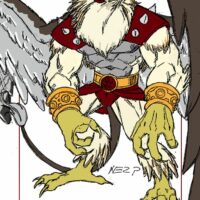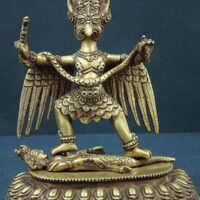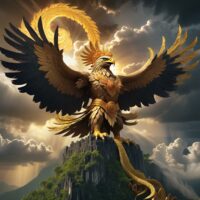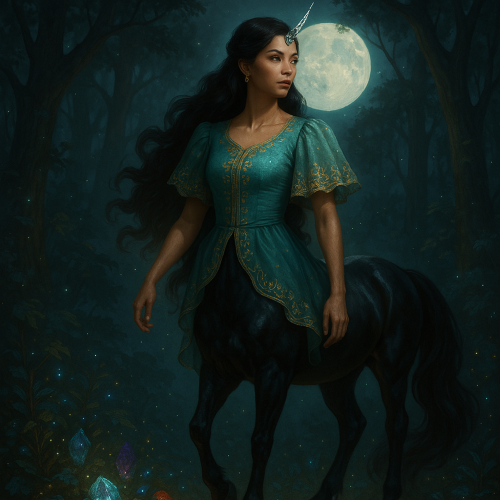Apung Galura : The Storm Bringer
Listen
At a glance
| Description | |
|---|---|
| Origin | Philippine Mythology |
| Classification | Hybrids |
| Family Members | N/A |
| Region | Philippines |
| Associated With | Wind, Sun |
Apung Galura
Introduction
Apung Galura is one of the most majestic and powerful figures in Kapampangan mythology, a tradition rooted in the central plains of Luzon in the Philippines. Revered as a giant eagle deity, Apung Galura is intimately linked with Mount Arayat and the forces of nature. As the storm-bringer and loyal servant of the sun god Apung Sinukuan, he plays a critical role in maintaining cosmic order. His myth bridges indigenous folklore with Indianized influences, reflecting centuries of cultural blending. More than a mythic beast, Apung Galura is a symbol of power, justice, and spiritual transformation, continuing to soar through the collective memory of the Kapampangan people.
Physical Traits
Apung Galura is envisioned as a vast eagle whose wings can stretch across the horizon. His form dominates the skies, and every flap of his wings is believed to stir the winds into powerful typhoons. His body gleams with the brilliance of the sun, suggesting his divine connection with light and fire. In mythic illustrations and oral descriptions, his presence is overwhelming, casting shadows across mountains and valleys. The bird is not only grand in size but also in symbolic weight, representing both awe and dread. Some cultural interpretations even credit him with physically supporting the sky, his talons gripping the heavens themselves.
Family
In the divine hierarchy of Kapampangan cosmology, Apung Galura serves under Apung Sinukuan, the powerful sun god who dwells in Mount Arayat. Galura acts as his emissary, executing the god’s will by purifying the earth through storms and delivering judgment upon souls. His role is not that of a deity ruling independently, but as a loyal servant and celestial enforcer. His position within this divine court reflects his trusted status—he is Sinukuan’s first general and often referred to as the úkum or judge. Through this divine partnership, Apung Galura becomes an integral part of the spiritual governance of the world, channeling the sun god’s energy into action.
Other names
While “Apung Galura” is the name most commonly used in the Kapampangan region, his identity is interwoven with other mythological traditions throughout Asia. In Hindu mythology, he closely resembles Garuda, the mount of Vishnu, known for slaying serpents and transporting gods. In Pali texts, the name transforms into Garula, while Japanese Buddhist traditions refer to him as Karura, a bird-like figure often surrounded by fire. These parallels suggest a shared Indo-Malay mythological ancestry, where divine bird beings served as intermediaries between gods and mortals. Within local syncretic practices, Galura is also compared to Saint Michael the Archangel, especially in visual talismans that depict him triumphantly defeating serpents or demonic forces, further embedding him into folk Catholic narratives.
Powers and Abilities
Apung Galura’s abilities are elemental, spiritual, and deeply symbolic. He is a master of the skies, capable of stirring fierce winds and summoning typhoons. His storms are not merely destructive—they are acts of purification, washing away impurities and setting the stage for renewal. As the úkum, he holds the power to weigh the souls of the dead, deciding their fates in the afterlife. In battles against primordial beings like Naga Lakandanum, a great water serpent, Galura displays his prowess as a serpent slayer, a recurring motif in Southeast Asian mythologies. His presence is also a source of hope for those lost at sea. Sailors caught in shipwrecks or dangerous currents would pray to Apung Galura for deliverance, trusting in his protective nature. His role as both destroyer and savior highlights a duality found in many deities associated with natural forces.
Modern Day Influence
Although not widely worshipped today, Apung Galura’s influence persists in subtle and significant ways throughout Kapampangan and broader Filipino culture. The surname “Galura” continues to appear in the region, carried by individuals such as the writer Felix Galura, who contribute to preserving Kapampangan identity through literature. In folk Catholicism, Apung Galura’s traits have been absorbed into the figure of Saint Michael, particularly in protective amulets and local processions. In the arts, he has inspired paintings, poems, and comics, particularly among creators aiming to revive Philippine mythological consciousness. Online platforms such as Siuálâ Ding Meángûbié and The Aswang Project have been instrumental in bringing Galura’s story to younger generations, providing detailed archives and interpretations that link traditional beliefs with modern storytelling. Through these digital spaces, Apung Galura remains aloft in the minds of those seeking to reconnect with indigenous spirituality.
Related Images
Source
HubPages. (2025, June 13). Top 5 Largest Creatures From the Philippine Mythology. https://discover.hubpages.com/education/top-five-largest-creatures-in-philippine-mythology
Substack. (2025, February 6). The Philippines and Indonesia: Two Sibling Nations and their …. https://substack.com/home/post/p-156154887?utm_campaign=post&utm_medium=web
The Aswang Project. (2017, June 9). The Role of Birds and Serpents in Philippine Mythology. https://www.aswangproject.com/role-birds-serpents-philippine-mythology/
Bigwas. (2023). Galura. Retrieved from https://www.bigwas.com/2023/03/galura.html
Siuálâ Ding Meángûbié. (2012). GALÚRÂ. Retrieved from http://siuala.com/diuata/galura/
Clark, J. (2017). Formation of the World Kapampangan Mythology. The Aswang Project. Retrieved from https://www.aswangproject.com/kapampangan-mythology/
Nicdao, A. (1917). Pampangan Folklore. Manila: Philippine Education Company.
HubPages. (2023). Philippine Mountain Goddesses: Maria Sinukuan. Retrieved from https://discover.hubpages.com/religion-philosophy/Maria-Sinukuan-The-Fairy-Godmother-Who-Turned-Men-Into-Swine-Mountain-Goddesses-of-the-Philippines-Part-2
Frequently Asked Questions
What is lorem Ipsum?
I am text block. Click edit button to change this text. Lorem ipsum dolor sit amet, consectetur adipiscing elit. Ut elit tellus, luctus nec ullamcorper mattis, pulvinar dapibus leo.
What is lorem Ipsum?
I am text block. Click edit button to change this text. Lorem ipsum dolor sit amet, consectetur adipiscing elit. Ut elit tellus, luctus nec ullamcorper mattis, pulvinar dapibus leo.
What is lorem Ipsum?
I am text block. Click edit button to change this text. Lorem ipsum dolor sit amet, consectetur adipiscing elit. Ut elit tellus, luctus nec ullamcorper mattis, pulvinar dapibus leo.
What is lorem Ipsum?
I am text block. Click edit button to change this text. Lorem ipsum dolor sit amet, consectetur adipiscing elit. Ut elit tellus, luctus nec ullamcorper mattis, pulvinar dapibus leo.
What is lorem Ipsum?
I am text block. Click edit button to change this text. Lorem ipsum dolor sit amet, consectetur adipiscing elit. Ut elit tellus, luctus nec ullamcorper mattis, pulvinar dapibus leo.









